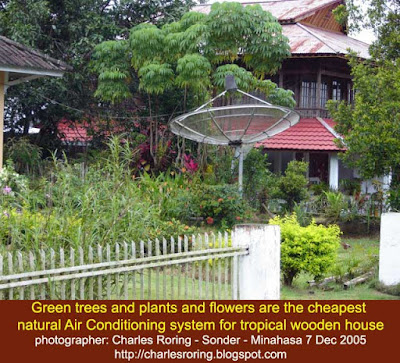Wooden house in tropical region needs an energy efficient air conditioning system. Most of the energy used in buildings is for air conditioning. In other words, the half of the green house gases that cause global warming come from the CO2 emissions that modern buildings produce every day. An environmentally friendly house needs to tackle this problem. Because the temperature of the tropical islands are high, between 29 to 32 degrees Celsius, wooden houses that are built in this region must have good ventilation holes that can let air to circulate naturally. The following photograph shows how the owner of wooden house of Minahasa use green plants and flowers as natural air conditioning system to cool the air temperature that circulates into and out of the house.
People usually plant trees around their houses to filter dirty air and at the same time lower the temperature of the air before it enters the house through ventilation holes that are made above the windows and doors of the wooden houses. Besides planting trees that provide shades to the roof of the house, home owners can grow plants as fence for their houses. Live plants will significantly reduce the amount of ash that fly together with the air when cars or motorcycles pass in front of their houses. Another natural air conditioning system that can be done to substitute the man-made AC machine is by constructing fish pond at the front yard of the house. Besides the pond can be considered as decoration, its water vapor greatly reduces the temperature of air that circulates into and out of the house.
With this natural AC system, home owners can reduce the electrical bill that they will likely to pay if they install man-made AC machines in their wooden houses. This kind of arrangement may not be applicable to wooden houses in the United States and Europe where insulation is very important to keep the indoor rooms warm during winter season. The natural air conditioning system for such houses can be done by the application of passive solar system to warm up the air that circulates inside the house without the need of a lot of electrical energy.
In a book entitled, Ecohouse: A Design Guide by Sue Roaf, it says that architects in Oxford of the UK have done extensive research in developing an energy efficient house that only emits 140 kg of CO2 per year. Houses in Oxford whose sizes are similar to the Oxford Eco-house emit 6500 kilograms of CO2 per year. So, it is still possible to develop an energy efficient or eco-friendly house in Europen countries where energy consumption during winter is relatively high.
We all know that most of the architects in the past 30 years have shut-off the indoor climate from the outdoor one. Such decision has systematically stopped the use of natural air circulation and heating system with man-made heating and AC machines. In eco-friendly wooden house design approach, the indoor and outdoor climate still connects to each other and carefully adjusted to create ideal temperature to people who will live inside it. The use of natural material such as timber and clay will reduce energy consumption. by Charles Roring
